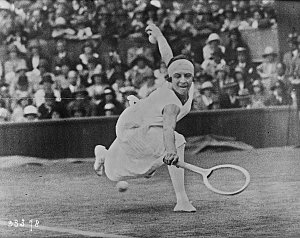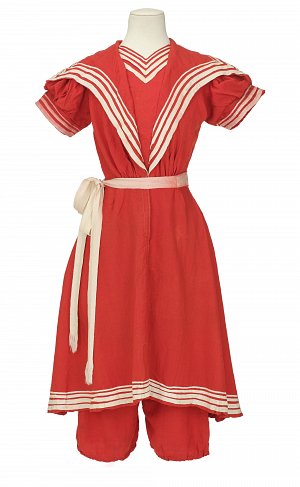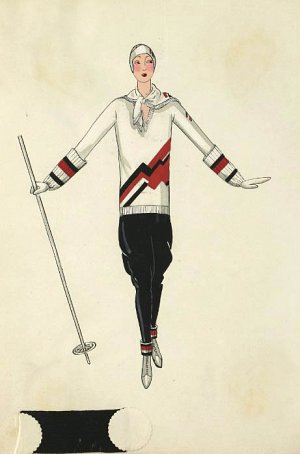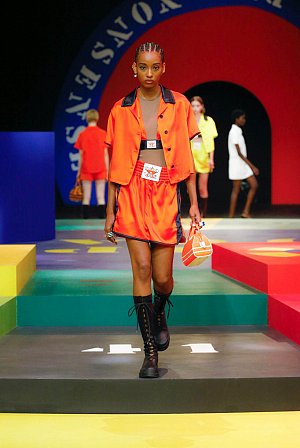Sports before sports

Miss Lenglen, tennis player at Wimbledon, 26 June 1924
Glass negative
Paris, Bibliothèque
nationale de France,
département
des Estampes
et de la photographie
© BnF
The exhibition layout is chronological even
if there are also a number of thematic
sections. A circular space introduces
the Ancient world, when sports were
associated with nakedness. Medieval
tournaments exemplify the Middle Ages,
and the jeu de paume represents the
Early Modern period. While medieval
illustrations show that clothing helped
to identify a jouster or company, the jeu
de paume emphasises the contradictory
pull of comfort and elegance during
a game. We can see that the white apparel
still associated with tennis today has its
roots in this game.
En selle ou en garde !
The first physical regimens were
developed to help aristocrats hone such
useful skills as hunting, archery or fencing.
Looking at their outfits in context, we can
see that while these leisure activities
were synonymous with refinement,
they also gave rise to new apparel, notably riding breeches for women.
Pictorial representations of historical
figures – including Marie-Antoinette –
illustrate this point.
Before sportswear became a byword
for comfort
Participation in sports increased in the
early 19th century in the wake of the
hygienists’ promotion of the health
benefits of physical activity. The rise
of gymnastics is examined in this
context, followed by team sports and
the introduction of football and rugby
shirts. Late 19th and early 20th century
wool jerseys are exhibited alongside
the first studded football boots and
cleats for athletics. In contrast, women’s
sportswear focused on elegant tennis,
golfing and croquet gowns. At the
end of the 19th century, the individual
sports favoured by the higher classes
presented an opportunity for social
distinction. Turn of the century paintings
and photographs – notably those
of Jacques-Henri Lartigue – comically
point to the gulf separating the outfits
of the first sporting women, with their
oversized hats, from contemporary
notions of active wear. Cycling soon
became popular with both sexes, and
the bloomers worn by cycling ladies
suggest that it even fostered the
emancipation of women.
From bathers to swimmers

Ladies two piece bathing costume (gown and drawers), c. 1900, France
Wool twill, wool muslin
© Les Arts Décoratifs / Christophe Dellière
Attitudes to bathing and swimming
helped to shape contemporary attitudes
to clothing. Immersed in watery sounds
and images, visitors discover the impact
of these practices on ideas of modesty
and perspectives on the body. From the
bathing costumes of the late 19th century,
which covered much of the body, to the
first bikinis of the 1940s, female swimmers
helped to make skimpier, form-fitting
swimwear more acceptable. Two piece
swimsuits were popular with champion
women swimmers in the interwar period,
before they became fashion items.
Swimwear also prompted explorations
of unisex clothing in the 1930s, when
the bathing suits of men and women
could look much the same. The exhibition
also introduces us to contemporary
innovations, notably the Speedo
bodysuit, considered akin to a form
of “technological doping” in 2008 after
its wearers beat a number of records.
The origins of sportswear
The interwar years were crucial for the
relationship between fashion and sports.
The first clothes specifically designed
as active wear started to appear, among
them the classic Lacoste polo shirt.
Fascinated by sporting events, great
designers also began to devise clothes
that combined comfort and elegance,
drawing inspiration from the world
of sports. Jean Patou, Jeanne Lanvin,
Elsa Schiaparelli and Gabrielle Chanel
were actively involved in the creation
of sportswear, as it was known even then.
Gliding on ice and on the streets

Jeanne Lanvin (1867-1946), Drawing “1928 Winter Sport” Collection
Gouache
© Patrimoine Lanvin
The exhibition explores a range
of activities loosely connected to the idea
of “gliding” over a surface. Winter sports
(mountain climbing, ice skating, skiing)
spurred technical innovations while also
making trousers increasingly acceptable
items of clothing for women. From the
gorgeous Hermès “sweaters” of the
1930s to the ski suits worn by Club Med
ski instructors in the 1980s, the exhibition
presents a whole new world of fashion.
Surfing and skateboarding, so central
to the countercultures of the second half
of the 20th century, have pride of place.
Both were associated with specific styles
of dress which the luxury fashion industry
was quick to pick up, as evidenced
by a couture surfing suit. Indeed, both
sports became so popular that they were
incorporated into the Olympic games.
This presents a challenge for sportswear
designers: how best to approach
a sport rooted in rebellion and a thirst
for freedom?
Sportswear: the new normal
In the second half of the 20th century,
sportswear became ubiquitous and started
to become integral to the wardrobes
of men and women alike. Fashion
designers themselves had very close ties
with sporting competitions. Indeed, some
designers had a sports career before
moving on to the catwalk. René Lacoste
immediately comes to mind, but other
figures are more unexpected, including
such illustrious names as Emilio Pucci,
who was on the 1936 Italian Olympic
team, and Ottavio Missoni, a champion
400 metre runner. Other designers, from
André Courrèges to Issey Miyake, and
from Balmain to Lanvi, worked closely with
the sports world, outfitting athletes in the
Olympic games. However, sportswear
really took off in the 1980s and 1990s,
as bodybuilding and aerobics shaped new
ideals of physical beauty.

Cyd Jouny (1968-, shoe designer), Soho trainers (Autumn – Winter 1993), Tandem trainers (Spring – Summer 1993), France
Suede, leather, cotton,
alcantara, perforated leather, inlaid and
overlaid with metallised
leather
© Les Arts Décoratifs / Jean Tholance
Gyms opened their doors in large numbers
to an influx of customers eager to sculpt
their bodies and achieve healthy, youthful
silhouette. This ideal travelled from the
USA to France where it was incarnated
by the celebrity duo Véronique and
Davina. Tracksuits, originally intended
for athletes in training, became staples
of urban wardrobes, especially under
the influence of the hip-hop movement
and fashion designers like Sonia Rykiel.
During this period, “tennis shoes” also
came to be known as “sneakers”: from
Stan Smith’s emblematic trainers to the
latest collectables, the exhibition displays
this evolution on one of its walls.

Briol, Lacoste advertising poster, 1933
© Archives Lacoste
Colours and logos
The exhibition emphasises the many roles
of colour and logos in fashion, from the
blue outfits of French sports teams to the
uses of neon colours. A Lacoste polo
shirt entirely made up of crocodile logos
and designed by the Campana brothers
illustrates the fashion world’s “logomania”.
Ready, steady, go… Fashion!
At the centre of the exhibition
is a contemporary fashion “running track”
overhung with golden rings in homage
to the Olympics. Photographs show
some of the sports stars who have been
particularly inspirational for fashion
designers, including Zinedine Zidane for
Dior, and Naomi Osaka for Louis Vuitton.

Maria Grazia Chiuri for Dior, Jacket, top and shorts; Ready-to-wear Spring – Summer 2022
France. Viscose. Paris, Dior Héritage collection
© Ludwig Bonnet
Models walk up and down the track
clad in the designs of some of the
prestigious couturiers who have drawn
inspiration from the rich and diverse
world of sports: we catch a glimpse
of a football motif on outfits by Comme
des Garçons and Paco Rabanne,
a baseball jacket in a collection presented
by Off-White... We also discover that
athletes themselves brought fashion
to the sporting world, including Serena
Williams and Andre Agassi, who sported
bold outfits on the tennis court, and
Surya Bonaly, who wore Christian Lacroix
designs at ice skating competitions.
In the background, podiums illuminate
the increasing number of collaborations
between great sportswear brands and
fashion designers. In 2003, Adidas and
Yohji Yamamoto pioneered this new type
of joint venture with the Y-3 collection.
Other collaborations are also presented,
notably those of Lacoste and Freaky
Debbie, Gucci and Adidas, and Balmain
and Puma. Last but not least, the
spectators in the stands use their outfits
to project a certain image at a sporting
event. From the elegant dresses that
ladies wore at the races in 1900 to the
football shirts of the RC-Lens football
team’s supporters, practices have seen
major changes over the years.
As René Lacoste quipped: “It’s not
enough to play and win. Style also
matters.”
This exhibition’s celebration of creativity
and innovation offers us a unique
perspective on the porous boundaries
between past, present and future.
It reminds us that fashion and sports are
not separate worlds but interconnected
forces that shape our everyday lives.
It also invites us to celebrate the bold
leaps of those who shaped this history,
helping us to imagine a future in which
fashion and sports will continue to inspire
us and each other.